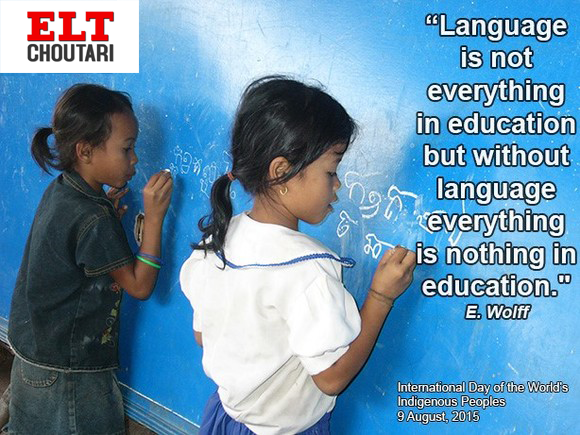On the occasion of International Day of the World’s Indigenous Peoples today, the Choutari team recognizes the importance of both local and global linguistic diversity and rich languages/language practices and cultural heritage knowledge of the indigenous people all over the world as a resource for building an equitable world in 21st century through quality education.

The spread of English as a global language has created numerous issues concerning educational policies and practices. Pushed particularly by the the ideology of “global market economy”, English is taken-for-granted as the language of education in developing countries. While the teaching of English as a language has already been a big challenge in ESL/EFL contexts, there is an increased push of English as the medium of instruction (EMI) policy from the early grades in Nepal. While the English language is certainly an important language in this globalizing world, it is not true that imposing English-only medium of instruction ensures a better education that prepares students for job market (which is becoming more multilingual and multicultural) nor is it justifiable that EMI promotes equity and access in education.
A famous linguist and scholar, David Crystal (2002) argues that the spread of English language has already created unprecedented “threat to many minority languages” all over the world. In Nepal, we have a mosaic of linguistic diversity which can be an important source of education. But EMI is pushed without considering any academic and language learning theories/studies. As they are facing a big pressure to increase student numbers, community/ public schools wrongly assume that the EMI policy will help them out to retain the students.
The EMI policy to lure parents to stop children from going to private schools is a perilous and an extremely reductionist view about education which lacks both academic and pedagogical justifications. The medium of instruction policy is one of the most important aspects of education as it is directly related to academic and cognitive development of children; to language and culture of society; and the education system as a whole. Thus, the creation and implementation of any language policy should be rigorous, comprehensive, and grounded on educational theories and best practices that embrace local existential reality while showing critical awareness of global issues.
Another key aspect to consider while developing a language policy is social justice and equity. Studies from all over the world have shown that allowing children to use their own home/community language as a primary language of education, while simultaneously learning second/foreign language, ensures greater student achievement. Further, the right to education in one’s own first language has been recognized as a fundamental right in all the global educational forums and policies that Nepal has already rectified and adopted its own policies.
In this backdrop, the government must be responsible to ensure its policies that are informed by educational practices and theories that support equitable and quality education for all children. We must be aware of the fact that “market forces” do not entirely determine and represent larger social and educational needs of the nation and as market resources are always hierarchical, they are not accessible to all children. Thus, we should first answer these questions: Do we really need EMI? When do we start EMI? What is the space of English in local linguistic diversity that shapes our educational practices? What should be the medium of assessment? Have we prepared teachers and created resources for EMI? What are the research-based foundations of EMI?
This August 2015 issue focuses on the above and other cross-cutting issues related to EMI policy in Nepal. We include case studies, pedagogical practices, and experts’ perspectives on EMI.
The first blog entry by Mahendra Kathet, a teacher trainer, is a case study of community schools from the Mt. Everest region which have recently adopted EMI. In the second post, Ashok Raj Khati, a teacher training specialist working for REED Nepal, further investigates into the EMI practices based on case studies, observations, and theoretical aspects.
In the third post, Ishwor Kandel, a master trainer of NIITE (National Initiative to Improve Teaching in English) project, highlights the need of EMI in schools and focuses on professional development of teachers to materialize the policy effectively. He also shares the ongoing NIITE project and its contents.
The fourth post is an interview with Khagaraj Baral, Executive Director of NCED. Mr. Baral believes that needs and interests of citizens are primary in democracy and if they want EMI in their schools, it should be up to them. With reference to SLC results of few EMI schools, he argues that EMI policy contributing to better results.
Prem Phyak, a PhD scholar, University of Hawaii, US, and Lecturer at the Department of English Education, Central Campus, Tribhuvan University, in another interview, shares research-based findings and situates them in Nepal’s current EMI policies and practices. He argues that the issue is not whether we need EMI policy, rather it is the accessibility and quality in education through EMI in the multilingual societies like Nepal. He argues that there is a need for redefining and reimagining language teacher education (including ELT/TESOL) and professional development programs (including teacher training) from a multilingual perspective. He asserts that there should be intensive research studies and critical examination of the current policies and practices before making any language policy decision.
Likewise, Bal Krishna Sharma,a PhD scholar of the University of Hawaii, shares that in the context of Nepal, where English is taught as a foreign language, teaching in English-only does not benefit the majority of students. Based on his research, he argues that whether we allow or not, translanguaging is in practice in our classes and he further suggests using both English and home language of students systematically to produce effective teaching learning outcomes.
Similarly, in another post, Pramod Kumar Sah, a research scholar on EMI at the University of Central Lancashire, shares his views on the prospects and challenges of implementing EMI in the context of Nepal. He presents the cases from all around and argues that EMI in Nepal has been a haste and unplanned decision. He also proposes to allow multilingual practices such as ‘translanguaging’ and ‘plurilingualism’ in the bilingual and multilingual classes of Nepal.
Last but not the least, we have continued the photo photography project. For the project, Photojournalist Sunil Sharma, who is also working for Chinese News Agency called Xinhua, contributes the photos from the classes in the temporary learning centers that were built to support children who could not go to schools after the April 25 earthquake.
Here is the list of the blog posts for the August Issue of Choutari:
- EMI in community schools: A case from Mt. Everest region by Mahendra Kathet
- EMI in Nepal: A passport to a competitive world or a commodity to sell?, A Case Study by Ashok Raj Khati
- Project NIITE: Developing Better Teachers for Implementing EMI by Ishwor Kadel
- Parents have Rights to Choose Medium of Instruction: Executive Director of NCED, an interview
- Reimagining EMI from a multilingual perspective: Policies/Practices, Realities and Looking Forward, by Prem Phyak
- Why English-only ideology and practice, by Balkrishna Sharma
- English Medium Instruction (EMI) in Nepalese Education:Potential or Problem? by Pramod Kumar Sah
- The Photography Project: Education in Emergencies, by Sunil Sharma
We hope that the views, opinions, and experiences in this issue will help shape EMI policies and practices in Nepal. I extend my sincere gratitude to the entire Choutari team for their support. Similarly, I am thankful to all the contributors for their amazing ideas on EMI! Last but not the least special thanks goes to Praveen Kumar Yadav for his untiring technical support!
Hoping that you would enjoy reading the special issue!
Happy readings!
